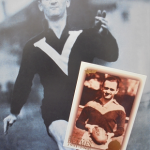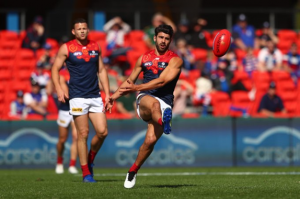Percy Beames
Nigel Dawe
The celebrated German thinker Georg Hegel once said: “Philosophy is a gallery of heroes of thought” and if he’d have grown up in Victoria at any time after 1858, then I dare say he may well have come up with the equally fitting line: “Footy is a gallery of heroes of sport.”
But humour aside and that said, I was prompted on a serious note to draft up something today to honour not just this season’s, but the game’s outright forgotten Demon, and inaugural triple Grand Final blitzing trail-blazer.
Not to take anything away from Dustin Martin, because his performance the other night in Brisbane was something all footy fans may well never forget; I say ‘may well’ because that is exactly the fate that awaited our fleet-footed boy from Ballarat, Percy Beames – the game’s first three-time Grand Final best on ground performer (in the consecutive Melbourne winning teams of 1939-40-41).
I’m not sure if it’s a simple case of oversight or just plain over-exuberance on the part of the footy community to extol the performances and virtues of a contemporary player (and ours wouldn’t be the first generation to fall into the same wide-eyed and appreciative trap) but I can’t imagine the same snub of a player’s efforts (irrespective of how long ago they ‘took place’) occurring in a sport like American baseball. That country’s ‘national sport’ is unlike any other in terms of the reverence they ensure is afforded ‘recollecting’ the memory and exploits – to a fact and stat, of their greats.
Not that it’s ever a safe or even a wise thing to compare the performances of players from different eras, though it is a fascinating undertaking: one not unlike wading into a thick smoke-filled house lined with a thousand haphazardly placed mirrors. But where the blur clears somewhat, enough to gain a glimpse of clarity for the purposes of an informed opinion, is in the basic tale that the stats tell.
Of the three Grand Finals Percy Beames and Dusty Martin left every other player in their tenacious wake, it’s worth first mentioning that Beams scored a total of 12 goals (as a rover) to Martin’s 10 goals (having played on the half-forward line in two of his three Grand Finals).
Again, this article is not about proving who performed better or is more earning of ultimate bragging rights, but the incredible ‘given’ of Beames’ big dance outings, was the fact he lined up against the white-hot calibre of captain and Brownlow medallist of both teams in 1939 (Harry Collier) and 1941 (Dick Reynolds). The 1941 heroics of Beames are made all the more extraordinary when you consider that Reynolds was an absolute all-time great, not to mention a triple-Brownlow winning trojan!
Then factor in Richmond’s Captain Blood, who literally prowled the turf for opposition scalps in the ‘hit-out’ of 1940, and you have the gleaming stage upon which Beames rose to stamp his authority on the toughest game of all, three times-in-a-row.
So as to clearly establish the standing and place that Percy Beames occupies at the club (he was the first Melbourne player to reach 200 games, as well as being a handy cricketer, and the only player in the entire post 1897/VFL-era to captain both the MCC and the MFC) you have to look no further than the fact there is a ‘Percy Beames Bar’ in the members section of the MCG. I don’t know about you, but that would have to take the cake, albeit eternally warm the grand old spirit of any former great!





 Follow us on twitter
Follow us on twitter Join our facebook group
Join our facebook group